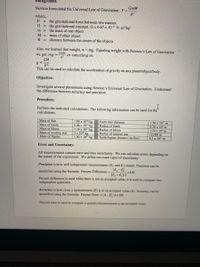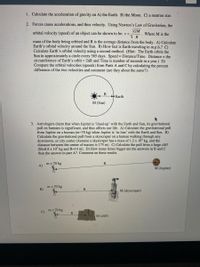
College Physics
11th Edition
ISBN: 9781305952300
Author: Raymond A. Serway, Chris Vuille
Publisher: Cengage Learning
expand_more
expand_more
format_list_bulleted
Question
Question answer #2

Transcribed Image Text:Background:
GmM
Newton formulated the Universal Law of Gravitation: F =
R2
where,
the gravitational force between two masses.
the gravitational constant, G = 6.67 x 101' N- m²/kg?
the mass of one object
mass of other object
distance between the center of the objects
F
G =
m =
M =
R =
Also, we learned that weight, w =mg. Equating weight with Newton's Law of Gravitation
we get: mg =
GmM
or canceling m:
R2
GM
g =
R2
This can be used to calculate the acceleration of gravity on any planet/object/body.
Objective:
Investigate several phenomena using Newton's Universal Law of Gravitation. Understand
the difference between accuracy and precision.
Procedure:
Perform the indicated calculations. The following information can be used for the
calculations.
| 1.50 x 10" m
6.38 x 10 m
1.74 x 10° m
12,000 m
6.3 x 10" m
Mass of Sun
1.99 x 100 kg
5.98 x 10²ª kg
7.36 x 1022 kg
2 x 100 kg
1.90 x 107 kg
Earth-Sun distance
Radius of Earth
Radius of Moon
Radius of neutron star
Earth-Jupiter distance (in-line)
Mass of Earth
Mass of Moon
Mass of neutron star
Mass of Jupiter
Error and Uncertainty:
All measurements contain error and thus uncertainty. We can calculate errors depending on
the nature of the experiment. We define two main types of uncertainty:
Precision is how well independent measurements (Ej and E2) match. Precision can be
|E - E|
quantified using the formula: Percent Difference =
x100
(E, + E,)/2
Percent difference is used when there is not an accepted value; it is used to compare two
independent quantities.
Accuracy is how close a measurement (E) is to an accepted value (A). Accuracy can be
quantified using the formula: Percent Error =|A-E/A×100
Percent error is used to compare a quantity/measurement to an accepted value.

Transcribed Image Text:1. Calculate the acceleration of gravity on A) the Earth. B) the Moon. C) a neutron star.
2. Forces cause accelerations, and thus velocity. Using Newton's Law of Gravitation, the
GM
orbital velocity (speed) of an object can be shown to be: v =
Where M is the
R
mass of the body being orbited and R is the average distance from the body. A) Calculate
Earth's orbital velocity around the Sun. B) How fast is Earth traveling in m.p.h.? C)
Calculate Earth's orbital velocity using a second method. (Hint: The Earth orbits the
Sun in approximately a circle every 365 days. Speed = Distance/Time. Distance = the
circumference of Earth's orbit = 2rR and Time is number of seconds in a year.) D)
Compare the orbital velocities (speeds) from Parts A and C by calculating the percent
difference of the two velocities and comment (are they about the same?).
Earth
M (Sun)
3. Astrologers claim that when Jupiter is 'lined-up' with the Earth and Sun, its gravitational
pull on humans is significant, and thus affects our life. A) Calculate the gravitational pull
from Jupiter on a human (m=70 kg) when Jupiter is 'in-line' with the Earth and Sun. B)
Calculate the gravitational pull from a skyscraper on a human walking through any
downtown, or city center (Assume a skyscraper has a mass of 1.2 x 10° kg, and the
distance between the center of masses is 175 m). C) Calculate the pull from a large cliff
(M=8.8 x 107 kg and R=14 m). D) How many times bigger are the answers in B and C
than the answer in part A? Comment on these results.
m = 70 kg
A)
R
M (Jupiter)
m = 70 kg
B)
M (skyscraper)
m = 70 kg
C)
R.
M (cliff)
Expert Solution
This question has been solved!
Explore an expertly crafted, step-by-step solution for a thorough understanding of key concepts.
This is a popular solution
Trending nowThis is a popular solution!
Step by stepSolved in 5 steps

Knowledge Booster
Learn more about
Need a deep-dive on the concept behind this application? Look no further. Learn more about this topic, physics and related others by exploring similar questions and additional content below.Similar questions
arrow_back_ios
arrow_forward_ios
Recommended textbooks for you
 College PhysicsPhysicsISBN:9781305952300Author:Raymond A. Serway, Chris VuillePublisher:Cengage Learning
College PhysicsPhysicsISBN:9781305952300Author:Raymond A. Serway, Chris VuillePublisher:Cengage Learning University Physics (14th Edition)PhysicsISBN:9780133969290Author:Hugh D. Young, Roger A. FreedmanPublisher:PEARSON
University Physics (14th Edition)PhysicsISBN:9780133969290Author:Hugh D. Young, Roger A. FreedmanPublisher:PEARSON Introduction To Quantum MechanicsPhysicsISBN:9781107189638Author:Griffiths, David J., Schroeter, Darrell F.Publisher:Cambridge University Press
Introduction To Quantum MechanicsPhysicsISBN:9781107189638Author:Griffiths, David J., Schroeter, Darrell F.Publisher:Cambridge University Press Physics for Scientists and EngineersPhysicsISBN:9781337553278Author:Raymond A. Serway, John W. JewettPublisher:Cengage Learning
Physics for Scientists and EngineersPhysicsISBN:9781337553278Author:Raymond A. Serway, John W. JewettPublisher:Cengage Learning Lecture- Tutorials for Introductory AstronomyPhysicsISBN:9780321820464Author:Edward E. Prather, Tim P. Slater, Jeff P. Adams, Gina BrissendenPublisher:Addison-Wesley
Lecture- Tutorials for Introductory AstronomyPhysicsISBN:9780321820464Author:Edward E. Prather, Tim P. Slater, Jeff P. Adams, Gina BrissendenPublisher:Addison-Wesley College Physics: A Strategic Approach (4th Editio...PhysicsISBN:9780134609034Author:Randall D. Knight (Professor Emeritus), Brian Jones, Stuart FieldPublisher:PEARSON
College Physics: A Strategic Approach (4th Editio...PhysicsISBN:9780134609034Author:Randall D. Knight (Professor Emeritus), Brian Jones, Stuart FieldPublisher:PEARSON

College Physics
Physics
ISBN:9781305952300
Author:Raymond A. Serway, Chris Vuille
Publisher:Cengage Learning

University Physics (14th Edition)
Physics
ISBN:9780133969290
Author:Hugh D. Young, Roger A. Freedman
Publisher:PEARSON

Introduction To Quantum Mechanics
Physics
ISBN:9781107189638
Author:Griffiths, David J., Schroeter, Darrell F.
Publisher:Cambridge University Press

Physics for Scientists and Engineers
Physics
ISBN:9781337553278
Author:Raymond A. Serway, John W. Jewett
Publisher:Cengage Learning

Lecture- Tutorials for Introductory Astronomy
Physics
ISBN:9780321820464
Author:Edward E. Prather, Tim P. Slater, Jeff P. Adams, Gina Brissenden
Publisher:Addison-Wesley

College Physics: A Strategic Approach (4th Editio...
Physics
ISBN:9780134609034
Author:Randall D. Knight (Professor Emeritus), Brian Jones, Stuart Field
Publisher:PEARSON